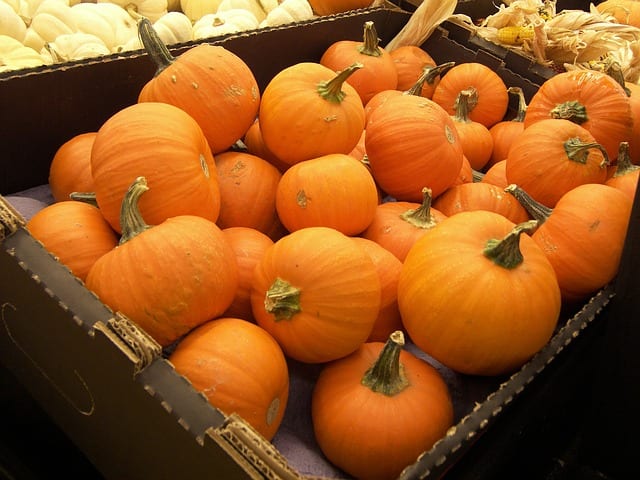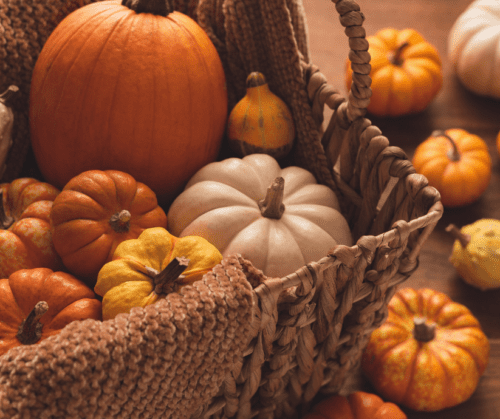While we’re not quite trying to push pumpkin spice your way, here at Rainbow Gardens, we ARE reminding you that if you want pumpkins this year, summer is the time to to plant them. If you want a harvest by the end of October and into November, you should probably get a move on. We have compiled a list of 7 tips to help you grow the most notable vegetable of the fall holiday months. Take a look at our list and read on to get more details about each tip. At the end of the article, you can also download a free, printable, infographic keep these tips handy.
7 Planting Tips for Pumpkins
- Plant at the right time.
- Choose the right type of pumpkin.
- Give pumpkins plenty of space to grow.
- Plant in well-draining soil.
- Offer pumpkins plenty of water.
- Offer pumpkins a high nitrogen fertilizer.
- Watch for specific pests and disease.

More About Planting Pumpkins
Plant at the right time. planting time for pumpkins in San Antonio is in summer! Generally it’s best to get those pumpkins planted June – mid July. But try to at least finish up by the end of July.
Choose the right type of pumpkin. Smaller to medium sized pumpkins generally do better here in San Antonio. Make sure you take note of how many days-to-harvest your chosen pumpkin is. Some mature around 84 days (smaller to medium) while other can take up to 120 days (large to giant). To have pumpkins by the holidays, you would need to count back from Thanksgiving or Halloween and make sure you’ve planted your seeds or transplants by then.
Offer pumpkins plenty of space to grow. Pumpkins are vining plants, and can really stretch out. 5-6 seeds should be planted in clusters, and the clusters should be spaced 4′-8′ apart in the rows. Rows should be planted 8′-10′ apart. Thin transplants to 2-3 plants in the cluster once they are growing well.
Plant in the right type of soil. Pumpkins cannot have ‘wet feet’. This means you need to make sure you are planting in well-draining soil. The addition of organic compost and peat moss can amend soil to drain better. Planting in raised beds can also help if you can’t amend soil enough for adequate drainage.
Offer plenty of water. You know it’s hot here in San Antonio during summer, and it’ll be tough for pumpkins to get established if they are struggling for water. Be hyper vigilant about watering during summer planting and also when the fruit is developing and maturing. Feel the soil to a depth of at least 2″. It shouldn’t be dry, and if it is, better get to watering. (Again, even with extra watering, you still need to make sure you have excellent drainage in your soil.
Use a high nitrogen fertilizer. About 2 weeks after seeds have germinated, offer pumpkins a dose of high nitrogen fertilizer, and then reapply every month through harvest. Follow the recommended rate on the fertilizer label, but in general, you want to offer about 1-2 lbs. per 100 sq. ft. bed.
Watch for specific pests and disease. pumpkins are in the curcubit family and can be attacked by all those pests and disese that affect squash, cucumbers, zuchinni, etc. But specifically you should watch out for squash bugs/squash borers. Follow these tips as these pests are easier prevented rather than controlled.
- Wrapping the base of stem with stretchy gauze, can help prevent squash borers from laying their eggs along the stem like they love to do (larvae than hatches and burrows, undetected, into the stem, eventually killing the plant).
- Row cover can also prevent adults from laying their eggs along the stem, but it can be difficult to make sure row cover is secure at every spot. Ad you also need to make sure you are not trapping pests in.
- Prop up a shingle of some sort close by the plants. Adult squash bugs will congregate under there for shade during the hottest parts of the day. You can them stomp on the shingle and kill the buggers!
- Check diligently along pumpkins stems (especially at the base), and under the leaves for egg masses, and you can wipe them off with your thumb and squish them. (Wear gloves if that creates and ick factor for you.) Checking diligently means checking every day. Observation = Prevention.
Also watch out for powdery mildew which can be prevented by avoiding watering the foliage. If it begins to appear due to cloudy, wet weather, it’s best controlled when caught early. Use a copper fungicide.

How about you carve some time out to plant a pumpkin in your vegetable garden? See what I did there? Here’s your downloadable tips.
~The Happy Gardener, Lisa Mulroy

